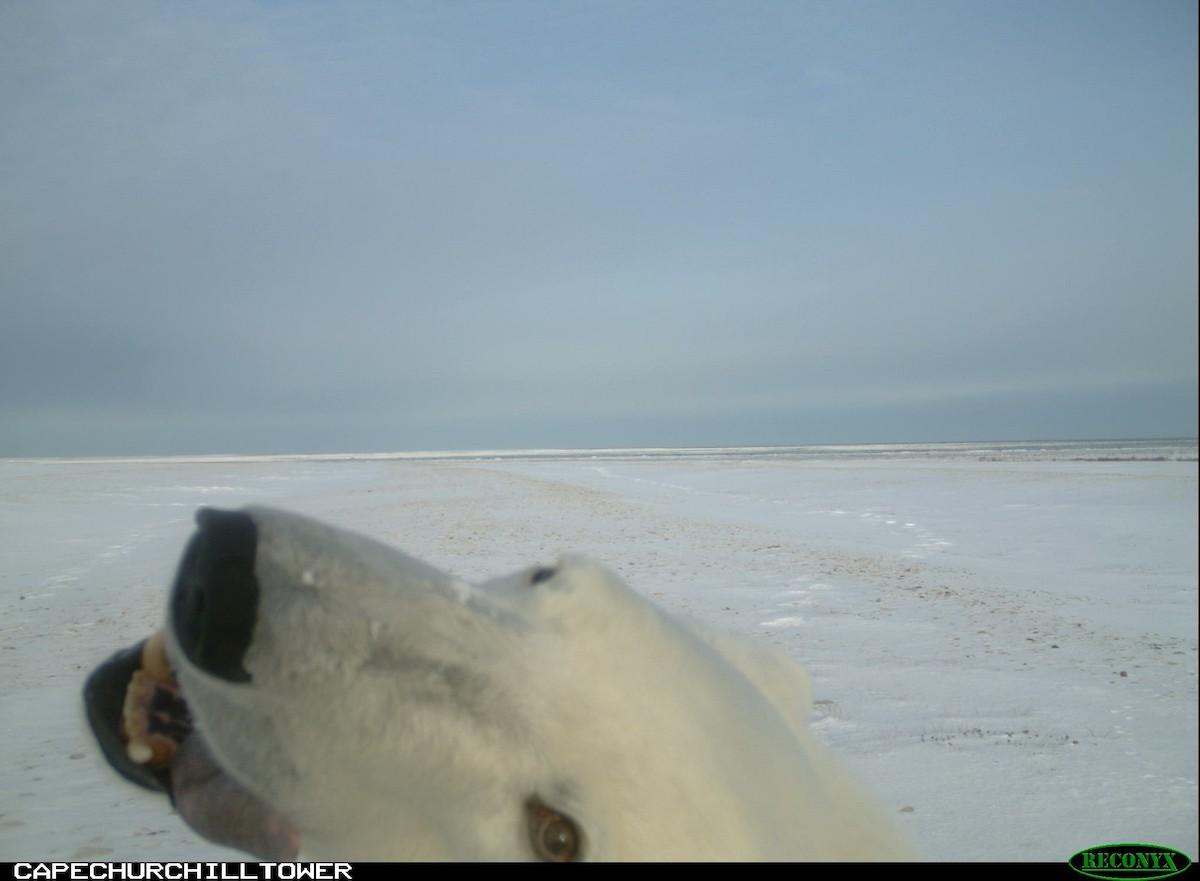
A remote camera captured this polar bear in Wapusk National Park in northern Manitoba/Parks Canada
To celebrate International Polar Bear Day on Feb. 27, Parks Canada has launched a polar bear “selfie” gallery of “sweet and silly poses” caught by remote cameras in Wapusk National Park.
“This means of wildlife monitoring not only provides some bear-y great photos, but helps Parks Canada help guide conservation and stewardship in the Northern Manitoba park, which protects one of the largest known concentrations of polar bear maternity dens in the world,” the Manitoba Field Unit said in an emailed release. “By getting a glimpse into bear behaviour, we can gain a better understanding of how they are adapting to a changing environment and how we address park management to ensure the protection of their home.”
The remote, northern park is along the shore of Hudson Bay near the town of Churchill.
The cameras are motion activated and take several pictures every time animals walk by. Each photo has a time stamp and date, plus details such as temperature and moon phase.

A curious polar bear cub shows up on this remote camera shot from March 19, 2022 in Wapusk National Park/University of Saskatchewan
The cameras have captured more than 68,000 animal images since 2011 and people can contribute to the Arctic Bears Project by helping to identify bear species. “Your help processing a decade’s worth of pictures from a changing sub-Arctic landscape is a critical conservation task,” Parks Canada said.
Wapusk is within the range of the Western Hudson Bay population of polar bears. Though the polar bear is designated as special concern under Canada’s Species At Risk Act, it has been listed as threatened under the province of Manitoba’s Species and Ecosystems at Risk Act.
Polar bears hunt seals from the sea ice. From late September to mid-November, many bears migrate north to the coast to catch the first pack ice of the winter. The number of bears peaks along the Cape Churchill peninsula from the town of Churchill to the northern tip of Wapusk.
When the ice of the Hudson Bay breaks up between early June and late July, the bears come ashore. Female bears — especially those that are pregnant or with cubs — travel inland to the denning area. Larger bears gather along the coast and become opportunistic feeders, largely fasting until they can hunt ringed seals again when the bay freezes. Pregnant females remain on land through the winter to give birth to their cubs and will fast for about eight months. Polar bears can slow their metabolism during the year which allows them to conserve energy when food supply is low.

The sweet face of a polar bear cub is captured by remote camera on Nov. 17, 2021/University of Saskatchewan
But due to climate change, the amount of time polar bears have to hunt on the sea ice has dropped by 25 days since the early 1980s.
Polar Bears International and explore.org have placed webcams at Cape Churchill in Wapusk, while Frontiers North Adventures offers two (the Tundra Buggy Cam and Tundra Buggy Lodge) from the Cape Churchill area.
Polar Bears International also installed a raven camera on Wapusk’s Cape Tower. These ravens have selected the topside of a radar reflector attached to the Cape Churchill observation tower. Dr. Ian Stirling built this structure to observe polar bear behavior starting in the 1970s and many biologists have called this cabin in the sky home while researching local wildlife. This camera is off at night to preserve power.
In 2008/2009, Parks Canada built fenced camps at Broad River and at the Owl River delta, away from the coastline to minimize the risk of encountering polar bears. After staff reported occasional bear sightings, they installed trail cameras in 2010.

Up close with a polar bear nose in Wapusk National Park/Parks Canada
In 2011, Parks Canada began working with Dr. Douglas Clark, a professor at the University of Saskatchewan and former Wapusk park warden. They installed more cameras to determine whether the camps were attracting polar bears and, if so, to provide information to help Parks Canada plan for human and bear safety at the camps. These professional-grade trail cameras operate day and night, year-round, and are triggered when their sensors detect moving warm objects. The cameras are bolted to the fence and are protected by heavy-duty steel cases. The flash is infra-red, minimizing disturbance to wildlife at night.
Researchers and park staff soon realized there was more to learn from the photos than originally expected. The cameras document precisely when the bears first come ashore in spring and when they move back onto the sea ice in winter. The images can also show how fat the bears are, which is an important influence on how many cubs they will have and how well they will survive. Researchers can often determine which bears are visiting the camps.
Parks Canada staff collect the memory cards each winter when the park is accessible by snowmobile. Cameras must often be dug out of snow drifts. The images are then sent to Clark and his team for research purposes. Images are also shared with Parks Canada to showcase the park and its wildlife to the public.

 Support Essential Coverage of Essential Places
Support Essential Coverage of Essential Places



